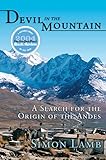Devil in the Mountain
Material type: TextPublication details: Princeton University PressDescription: 336 pagesISBN:
TextPublication details: Princeton University PressDescription: 336 pagesISBN: - 9780691115962
- 558
- QE230
| Item type | Current library | Call number | Copy number | Status | Date due | Barcode | |
|---|---|---|---|---|---|---|---|
 Book
Book
|
Lake Chapala Society | 558 LAMB (Browse shelf(Opens below)) | 1 | Available | 46145 |
Browsing Lake Chapala Society shelves Close shelf browser (Hides shelf browser)

|

|

|

|

|

|

|
||
| 551.7 FORT Earth | 553.6 KURL Salt: A World History | 557 BROW Cycles of Rock and Water: Upheaval at the Pacific Edge | 558 LAMB Devil in the Mountain | 567.9 HORN How to Build a Dinosaur | 569 JOHA Lucy's Child | 569.67 McKA Discovering the Mammoth: A Tale of Giants, Unicorns, Ivory, and the Birth of a New Science |
How do high mountain ranges form on the face of the Earth? This question has intrigued some of the greatest philosophers and scientists, going back as far as the ancient Greeks. Devil in the Mountain is the story of one scientist, author Simon Lamb, and his quest for the key to this great geological mystery. Lamb and a small team of geologists have spent much of the last decade exploring the rugged Bolivian Andes, the second highest mountain range on Earth--a region rocked by earthquakes and violent volcanic eruptions. The author's account is both travelogue and detective story, describing how he and his colleagues have pursued a trail of clues in the mountains, hidden beneath the rocky landscape. Here, the local silver miners strive to appease the spirit they call Tio-the devil in the mountain. Traveling through Bolivia's back roads, the team has to cope with the extremes of the environment, and survive in a country on the verge of civil war. But the backdrop to all these adventures is the bigger story of the Earth and how geologists have gone about uncovering its secrets. We follow the tracks of the dinosaurs, who never saw the Andes but left their mark on the shores of a vast inland sea that covered this part of South America more than sixty-five million years ago, long before the mountains existed. And we learn how to find long lost rivers that once flowed through the landscape, how continents are twisted and torn apart, and where volcanoes come from. By the end of their journey, Lamb and his team turn up extraordinary evidence pointing not only to the fundamental instability of the Earth's surface, but also to unexpected and profound links in the workings of our planet.
There are no comments on this title.
